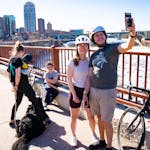Sara Beal sat on her porch, flipping through the mail, as a woman in a red Cadillac laid on the horn a half-block away.
The driver was trying to turn right on Franklin Avenue last week but was flummoxed by the hopelessly backed-up westbound lanes of Franklin.
Traffic is flooding into neighborhoods south of downtown Minneapolis because of construction projects that have closed bridges and interchanges near the junction of I-35W and 94. The displaced cars have clogged one-way thoroughfares Portland and Park avenues, and impatient drivers dart down side streets to get downtown or escape at the end of the day.
"People are trying to find a shortcut," said Beal, who lives on Oakland Avenue, a normally quiet street between Park and Portland. While it doesn't bother her personally, "kids live on this street," she said.
With more closures scheduled, south Minneapolis neighborhoods such as Phillips, Whittier and Elliot Park can expect to feel the pressure.
The construction mostly affects two distinct groups — commuters from the south metro headed into and out of downtown Minneapolis, and Minneapolitans trying to go from one side of 35W to the other.
The posted detours route commuters from the south metro onto Third Street or Washington Avenue to get into downtown, but in the first week since the closure of the major 35W entries into downtown Minneapolis, drivers have been testing different routes.
"People are starting to find new patterns," said Allan Klugman, a traffic engineer for the city of Minneapolis. "We usually say it takes about two weeks for things to settle down."
Starting this week, drivers will have even fewer options: 46th Street will be the only way for most cars to get on or off 35W in south Minneapolis, and the freeway will be reduced from 10 lanes to five. With bridges opening and closing on staggered timelines for the foreseeable future — for instance, the Franklin Avenue bridge is set to reopen this summer — the situation will be changing all the time.
City workers are monitoring streets in south Minneapolis by camera, on foot, by car and by bicycle, Klugman said, and have made the traffic lights on Third Street and Washington Avenue more favorable to commuters heading into downtown in the morning.
"We hope people follow the detour routes," Klugman said. "If they go through neighborhoods, remember that people live there."
By bike or bus?
The city is encouraging more people to ride public transit by dedicating one lane of traffic in the morning to buses on Park Avenue and one lane to buses on Portland Avenue in the afternoon. Motorists aren't completely obeying the signs yet, but the new regime is only one week in, Klugman said.
"Anecdotally, we've seen higher ridership on the Blue Line," said Howie Padilla, a spokesman for Metro Transit.
He said he will have hard numbers on Blue Line and bus ridership this week.
To help east-west cyclists, the city has installed a reverse bike lane on 28th Street, a one-way street that is one of the few major bridges open across the freeway in near south Minneapolis. Klugman said the city has not considered closing bike lanes on Portland and Park to ease auto traffic congestion. "We were committed to keeping the bike facility open throughout construction," he said.
Robert Bailey, who lives at the corner of 24th Street and Oakland, sat on his back driveway last week and chewed on a cigar. Cars were backed up a block away on southbound Portland, and it's harder to get places from his house, but he said traffic hasn't become a quality-of-life issue on his block.
"A little bit more than usual, but not really to the point that you'd call it congestion," Bailey said. "I'll be glad when they get it all fixed. What they need to be doing is focusing on these potholes."
Adam Belz • 612-673-4405 Twitter: @adambelz



![The Minneapolis City Council will decide the fate of the Hiawatha Golf Club tonite.]Richard Tsong-Taatariiïrtsong-taatarii@startribune.com](https://arc.stimg.co/startribunemedia/ADUODMQ7E6DUSYX6CVNZGT27IE.jpg?w=75&h=75&fit=crop&crop=faces)
